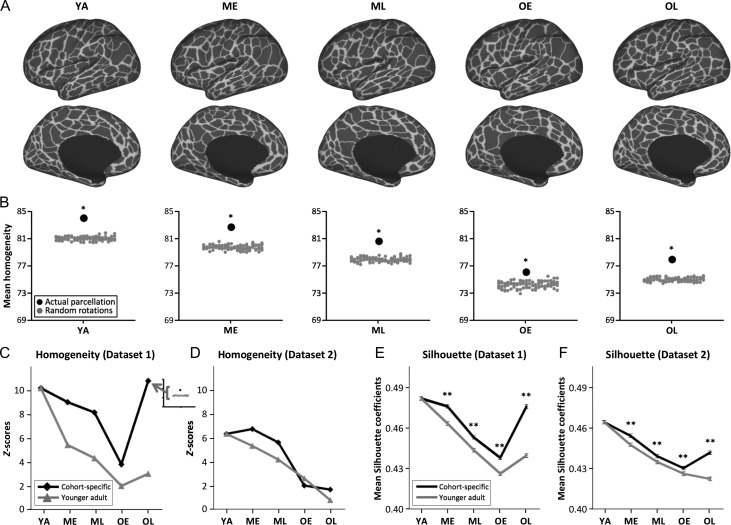Figure 2.
Cohort-specific functional parcellations of Dataset 1 derived from RSFC-based boundary detection are of high quality and provide a better “fit” to data from their own age range, compared with parcellation defined from younger adults. (A) Functional parcels of 5 age cohorts, calculated from their corresponding boundary maps. (B) For each cohort-specific parcellation, parcels exhibit significantly greater homogeneity of their vertices’ RSFC maps (black dots) relative to corresponding null model iterations (gray dots). (C) Z-scores of homogeneity values are plotted for cohort-specific parcellations and YA parcellation applied to each cohort’s dataset. The homogeneity of both cohort-specific and YA parcellations are significantly higher than their corresponding null models, however, cohort-specific parcellations provide a better representation of their corresponding data, as indicated by higher homogeneity Z-scores. The homogeneity values in Dataset 1 were evaluated from the same data as was used to derive the parcellations. (D) As in (C), except using a separate dataset (Dataset 2) for homogeneity evaluation. Cohort-specific parcellations exhibit higher homogeneity Z-scores than YA parcellation in ME, ML, and OL cohorts. (E, F) Mean Silhouette coefficients of cohort-specific parcellations are significantly higher than YA parcellation in both datasets, suggesting greater reliability of cohort-specific parcellations to define brain areas in their corresponding age ranges. Error bars indicate 95% confidence intervals of mean coefficients. Significance levels for Z-scores of homogeneity and 2-sample t-tests of Silhouette coefficient: *P < 0.01; **P < 0.001.

